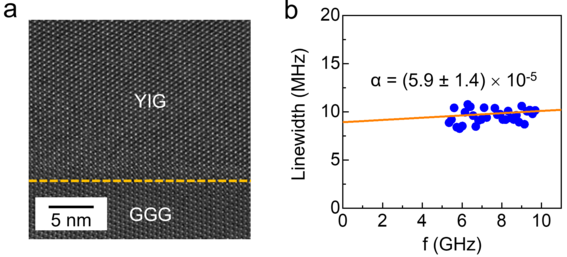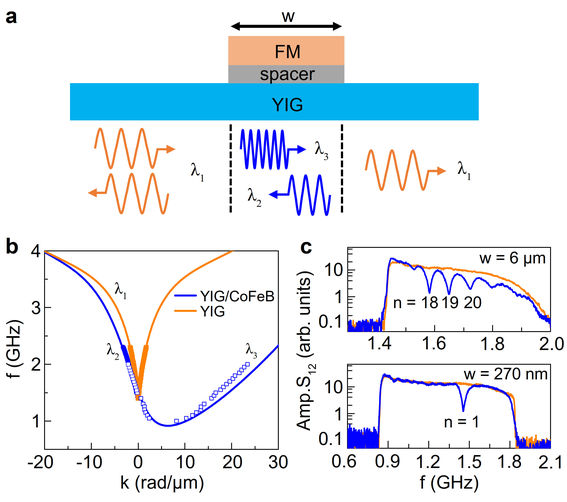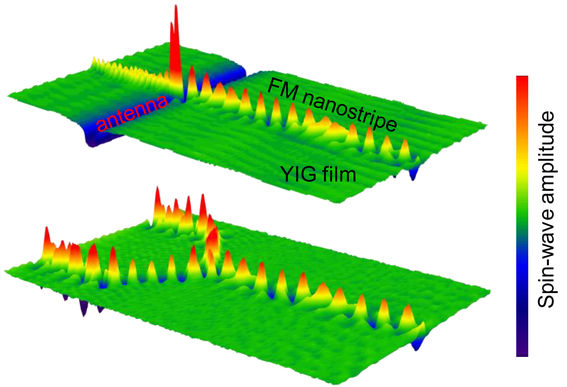Magnonics

Magnonics aims at the exploitation of spin waves for information transport, storage, and processing. Practical realizations of disruptive magnonic technologies require versatile methods for efficient spin-wave excitation, manipulation, and detection. We pursue new approaches to these essential functions using low-loss YIG films, which we grow by pulsed laser deposition (PLD) [4]. We operate two PLD systems and use various optimized processes for the growth of YIG films with ultralow magnetic damping, substituted YIG films with perpendicular magnetic anisotropy, and suspended YIG microstructures. Using advanced microfabrication, we demonstrated nanometer-thick YIG-based magnonic crystals with large tunable bandgaps [6,7]. The magnonic crystals in these studies consist of a small number of air or CoFeB-filled grooves. We also integrated magnonic crystals into straight, curved, and Y-shaped YIG waveguides.

As a new materials platform for low-loss nanoscale magnonics, we explore hybrid structures made of low-damping continuous YIG films and patterned ferromagnetic nanostructures. For instance, we have demonstrated short-wavelength spin-wave emission from an exchange-coupled YIG/CoFeB interface [3]. We also realized a magnonic analog of the Fabry-Pérot resonator by patterning ferromagnetic nanostripes on top of YIG films with a thin spacer [8]. In this configuration, dipolar coupling between the two magnetic layers produces an asymmetrical spin-wave dispersion within the bilayer region. Consequently, the two edges of the bilayer act as interfaces where the wavelength of spin waves converts upon reflection or transmission. Analogous to an optical Fabry-Pérot resonator, destructive interference of the spin waves entering and the spin waves circulating the bilayer region produces gaps at discrete frequencies in the transmission spectrum. Proper circulation of propagating spin waves within the resonator is facilitated by ultralow magnetic damping in the YIG film. Because the wavelength of spin waves within the bilayer converts down, the size of the resonator can be ultrasmall compared to the wavelength of incoming spin waves. In addition, magnetic switching in the Fabry-Pérot resonator actively controls the transmission signal. We currently work on the realization of magnonic neural networks using Fabry-Pérot nanoresonators.

As another example of a new hybrid magnonic structure, we demonstrated long-distance guiding of SWs along nanoscopic channels in continuous YIG films with patterned ferromagnetic stripes on top [12]. By taking advantage of ultralow damping in YIG and avoiding nanopatterning of this sensitive material, we measured spin-wave decay lengths of 20 micrometers in 160−400 nanometer wide waveguides at small magnetic bias fields. Our hybrid materials platform enables low-loss spin-wave transport through bends, providing a new strategy for the implementation of magnonic devices and integrated circuits without YIG nanopatterning.

Besides our work on YIG films, we also fabricate three-dimensional suspended YIG microstructures with low magnetic damping. We are particularly interested in bridges, which we operate as micromechanical resonators for studies on off-resonant magnon-phonon coupling, and suspended YIG microcavities for demonstrating strong coupling between optical whispering gallery modes and confined magnon states. We fabricate the suspended YIG structures by an advanced optical lithography process. Key steps in the process flow include lift-off of room-temperature grown YIG films and crystallization of the three-dimensional YIG structures using post-deposition annealing.

Leveraging the unique magnetic properties of ferromagnetic/ferroelectric bilayers, we have demonstrated short-wavelength spin-wave emission from oscillating magnetic domain walls [1] and globally excited magnetic anisotropy boundaries [2]. We have also shown that spin-wave transmission through a pinned magnetic domain wall can be switched on and off through active programming of the domain-wall spin structure. Most recently, we realized voltage control over the amplitude and phase of propagating spin waves in a multiferroic system [9] and we demonstrated zero-field routing of spin waves in a ferromagnetic/ferroelectric bilayer [10].
Publications
1. B. Van de Wiele, S.J. Hämäläinen, P. Baláz, F. Montoncello, S. van Dijken. Tunable short-wavelength spin wave excitation from pinned magnetic domain walls. Scientific Reports 6, 21330, (2016).
2. S.J. Hämäläinen, F. Brandl, K.J.A. Franke, D. Grundler, S. van Dijken. Tunable short-wavelength spin-wave emission and confinement in anisotropy-modulated multiferroic heterostructures. Physical Review Applied 8, 014020 (2017).
3. H. Qin, S. Hämäläinen, S. van Dijken. Exchange-torque-induced excitation of perpendicular standing spin waves in nanometer-thick YIG films. Scientific Reports 8, 5755 (2018).
4. H. Qin, S.J. Hämäläinen, K. Arjas, J. Witteveen, S. van Dijken. Propagating spin waves in nanometer-thick yttrium iron garnet films: Dependence on wave vector, magnetic field strength, and angle. Physical Review B 98, 224422 (2018).
5. S.J. Hämäläinen, M. Madami, H. Qin, G. Gubbiotti, S. van Dijken. Control of spin-wave transmission by a programmable domain wall. Nature Communications 9, 4853 (2018).
6. H. Qin, G-J. Both, S.J. Hämäläinen, L. Yao, S. van Dijken. Low-loss YIG-based magnonic crystals with large tunable bandgaps. Nature Communications 9, 5445 (2018).
7. H. Qin, S. van Dijken. Nanometer-thick YIG-based magnonic crystals: Bandgap dependence on groove depth, lattice constant, and film thickness. Applied Physics Letters 116, 202403 (2020).
8. H. Qin, R.B. Holländer, L. Flajšman, F. Hermann, R. Dreyer, G. Woltersdorf, S. van Dijken. Nanoscale magnonic Fabry-Pérot resonator for low-loss spin-wave manipulation. Nature Communications 12, 2293 (2021).
9. H. Qin, R. Dreyer, G. Woltersdorf, T. Taniyama, S. van Dijken. Electric-field control of propagating spin waves by ferroelectric domain-wall motion in a multiferroic heterostructure. Advanced Materials 33, 2100646 (2021).
10. W. Zhu, H. Qin, L. Flajšman, T. Taniyama, S. van Dijken. Zero-field routing of spin waves in a multiferroic heterostructure. Applied Physics Letters 120, 112407 (2022).
11. A. Krysztofik, N. Kuznetsov, H. Qin, L. Flajšman, E. Coy, S. van Dijken. Tuning of magnetic damping in Y3Fe5O12/metal bilayers for spin-wave conduit termination. Materials 15, 2814 (2022).
12. H. Qin, R.B. Holländer, L. Flajšman, S. van Dijken. Low-loss nanoscopic spin-wave guiding in continuous yttrium iron garnet films. Nano Letters 22, 5294 (2022).
13. N. Kuznetsov, H. Qin, L. Flajšman, S. van Dijken. Tuning of spin-wave transmission and mode conversion in microscopic YIG waveguides with magnonic crystals. Journal of Applied Physics 132, 193904 (2022).
14. L. Flajšman, O. Wojewoda, H. Qin, K. Davidkova. M. Urbanek, S. van Dijken. Wideband Brillouin light scattering analysis of spin waves excited by a white-noise RF generator. Applied Physics Letters 121, 232402 (2022).
15. R. Mansell, T. Schaffers, R.B. Holländer, H. Qin, S. van Dijken. Interaction of propagating spin waves with extended skyrmions. Applied Physics Letters 121, 242402 (2023).
16. A. Talapatra, H. Qin, F. Schulz, L. Yao, L. Flajšman, M. Weigand, S. Wintz, S. van Dijken. Imaging of short-wavelength spin waves in a nanometer-thick YIG/Co bilayer. Applied Physics Letters 122, 202404 (2023).
17. A.A. Nikitin, N. Kuznetsov, S. van Dijken, E. Lähderanta. Dynamic electromagnonic crystals based on ferrite-ferroelectric thin film multilayers. Physical Review B 109, 024440 (2024).
18. W. Zhu, H. Qin, S. van Dijken. Nanoscopic spin-wave channeling along programmable magnetic domain walls in a CoFeB/BaTiO3 multiferroic heterostructure. Applied Physics Letters 124, 042401 (2024).
19. Y. Wang, W. Yan, N. Kuznetsov, L. Flajšman, H. Qin, S. van Dijken. Spin-wave diffraction, caustic beam emission, and Talbot carpets in a yttrium iron garnet film with magnonic Fabry-Perot resonator gratings. Physical Review Applied 22, 014038 (2024).
20. N. Kuznetsov, H. Qin, L. Flajšman, S. van Dijken. Optical control of spin waves in hybrid magnonic-plasmonic structures. Science Advances 11, eads2420 (2025).
21. A. Lutsenko, K.G. Fripp, L. Flajšman, A.V. Shytov, V.V. Kruglyak, S. van Dijken. Magnonic Fabry-Pérot resonators as programmable phase shifters. Applied Physics Letters 126, 082406 (2025).
Reviews, roadmaps, book chapters
22. S. Hämäläinen, H. Qin, and S. van Dijken. Emission an Active Manipulation of Spin Waves in Multiferroic Heterostructures. In Three-Dimensional Magnonics (Jenny Stanford Publishing, 2019).
23. A. Barman et al. The 2021 magnonics roadmap. Journal of Physics: Condensed Matter 33, 413001 (2021).
24. A.V. Chumak et al. Advances in magnetics: Roadmap on spin-wave computing. IEEE Transactions on Magnetics 58, 0800172 (2022).
25. G. Gubbiotti et al. 2025 roadmap on 3D nanomagnetism. Journal of Physics: Condensed Matter 37, 143502 (2025).






